 |
|
|
|
Tue, 14 Oct, 2025
|

|

|
| Battle of Sitka |
| Part of the Russian colonization of the Americas |
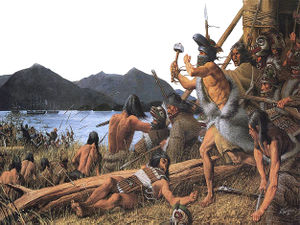
Battle of Sitka by Louis S. Glanzman, 1988 |
| Date: |
October, 1804 |
| Location: |
Sitka, Alaska |
| Result: |
Decisive Russian victory |
|
Casus belli: |
{{{casus}}} |
| Territory changes: |
{{{territory}}} |
|
| Combatants |
| Russia |
Tlingit Kiks.ádi Clan |
| Commanders |
|
Alexandr Baranov |
Chief Katlian |
| Strength |
150 Russians plus
400 Aleuts |
750–800 (estimated) |
| Casualties |
| 12 killed, many wounded |
unknown |
| {{{notes}}} |
The Battle of Sitka ( 1804) was the last major armed conflict between Europeans and Alaskan Natives, and was initiated in response to the destruction of a Russian trading post two years prior. The primary combatant groups were the native Tlingits of Sheet’-ká X'áat'l ( Baranof Island) and agents of the Russian-American Company.Though the Russians' initial assault (in which Alexandr Baranov, head of the Russian expedition, sustained serious injuries) was repelled, their naval escorts bombarded the Tlingit fort Shis'kí Noow mercilessly, driving the natives into the surrounding forest after only a few days. The Russian victory was decisive, and resulted in the Tlingit being permanently displaced from their ancestral lands. The Tlingit fled north and established a new settlement on the neighboring Chichagof Island.Animosity between the two cultures, though greatly diminished, continued in the form of sporadic attacks by the natives against the Russian settlement as late as 1858. The battlefield location has been preserved at Sitka National Historical Park. In September 2004, in recognition of the Battle's bicentennial, a direct descendent of Russian battle leader Baranov joined with descendents of the Kiks.ádi warriors for a traditional Tlingit "Cry Ceremony" to formally grieve for their lost ancestors.
 Jump to Page Contents Jump to Page Contents
|
|

Pay as you go
No monthly charges. Access for the price of a phone call
Go>
Unmetered
Flat rate dialup access from only £4.99 a month Go>
Broadband
Surf faster from just £13.99 a month Go> |
Save Even More
Combine your phone and internet, and save on your phone calls
More Info> |
This weeks hot offer
 24: Series 5
24: Series 5
In association with Amazon.co.uk £26.97 |
|
Contents
 Background Background
 Russian reprisal Russian reprisal
 Aftermath Aftermath
 Historic designations Historic designations
 Background - Contents Background - Contents
Members of the Kiks.ádi (Frog/ Raven Clan) of the indigenous Tlingit people had occupied portions of the Alaska Panhandle, including Sheet’-ká X'áat'l (present-day Baranof Island), for some 10,000 years. Alexandr Baranov (Chief Manager of the Shelikhov-Golikov Company, a forerunner of the Russian-American Company) first visited the island aboard the Ekatarina in 1795 while searching for new sea otter hunting grounds. Baranov paid the Tlingit a small sum for the rights to the land in order to prevent "interlopers" from conducting trade on the island.On May 25, 1799 Baranov and 100 employees of the RAC (accompanied by their native wives) sailed into Sitka Sound aboard the cutter Olga and sloop-of-war Konstantin of the Imperial Russian Navy; accompanying the Russian settlers was a fleet of some 550 baidarkas, carrying 600–1,000 Aleut escorts. Wishing to avoid a confrontation with the natives, the group passed by the strategic hilltop encampment where the Tlingit had established their Noow Tlein ("Big Fort") and made landfall at their second-choice building site, some 7 miles (11 kilometers) north of the colony. The location of the Russian settlement at Katlianski Bay, " Redoubt Saint Michael," is known today as "Starry Gavan" (Starrigavan) Bay, or "Old Harbor." The outpost consisted of a large warehouse, blacksmith shop, cattle sheds, barracks, stockade, block house, a bath house, quarters for the hunters, and a residence for Baranov.
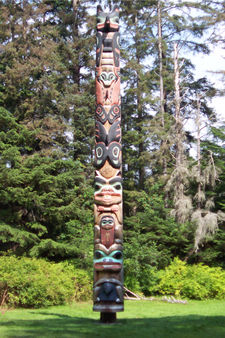 The Tlingit K'alyaan Pole, erected at the site of Fort Shis'kí Noow in Sitka National Historical Park to commemorate the lives of those lost in the Battle of Sitka.
Though the Kolosh (the Russian name for the Tlingit) initially welcomed the newcomers, their animosity toward the Russians grew in relatively short order. The Kiks.ádi objected to the Russian traders' custom of taking native women as their wives, and were constantly taunted by other Tlingit clans who looked upon the "Sitkas" as the outsiders' kalga, or slaves. Perhaps the tribe was jealous of the Aleuts' superior skills at hunting sea otters as well. The Kiks.ádi came to realize that the Russians' continued presence demanded their allegiance to the Tsar, and that they therefore were expected to provide free labor to the Company Competition between the two groups for the island's resources would escalate as well.Despite a number of unsuccessful Tlingit attacks against the post during the winter of 1799, business soon prospered. Urgent matters required that Baranov return to Kodiak (then capital of Russian America) in 1800. 25 Russians and 55 Aleuts, under the direction of Vasilii G. Medvednikov, were left to staff the post. In spring, 1802 the population of Redoubt Saint Michael had grown to include 29 Russians, 3 British deserters, 200 Aleuts, and a few Kodiak women. It was rumored that the British (under the auspices of the Hudson Bay Company) staged a meeting with the northern Tlingit clans in Angoon in 1801, wherein they offered muskets and gunpowder to the Tlingits in exchange for exclusive fur trading rights.On June 20, 1802 a horde of Tlingit warriors from along Kaasda Héen (the Indian River) and nearby Crab Apple Island, "painted like demons" and wearing animal masks carved out of wood, attacked the Russian fort. The natives were well-armed with spears and modern firearms (the latter acquired through trade with the British, French, Spanish, and Americans, whose ships frequented the waters of the Inside Passage). Led by Chief Shk'awulyéil, the raiding party massacred all of the men (20 Russians and close to 130 Aleut workers), looted and burned the barracks and storehouses, destroyed a ship under construction, and enslaved the surviving women and children.A few Russians and Aleuts who had been away from the post hunting, or who had fled into the forest, subsequently reached safety and relayed news of the attack to two foreign ships at anchor in the Sound. After brief negotiations, the Tlingit agreed to ransom a few of the survivors to the commander of the American ship Alert out of Boston. Captain James Barber of the British ship Unicorn, also anchored nearby, lured Shk'awulyéil and several of his raiders aboard and placed them in the brig, subsequently exchanging them for the remaining lone Russian and 18 Aleut captives (along with some 4,000 sea otter pelts that had been plundered during the raid).The Unicorn then set sail for Kodiak, where it delivered the survivors and the news of the attack to Baranov on June 24. Barber extracted a ransom of 10,000 rubles for the return of the colonists — a mere 20% of his initial demand.
 Russian reprisal - Contents Russian reprisal - Contents
Following the Kiks.ádi victory, Tlingit Shaman Stoonookw (confident that the Russians would soon return, and in force) urged the Clan to construct a new fortification that was capable of withstanding cannon fire, and provided an ample water supply. Despite strong opposition, the Shaman's will prevailed, and the Kiks.ádi made preparations for war. The Sitkas sent messages to their allies requesting assistance, but none was forthcoming; they would face the Russian fleet on their own.
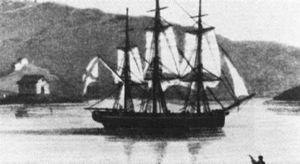 The Russian sloop-of-war Neva visits Australia in 1807.
The Tlingit chose to construct the roughly 240 feet by 165 feet (73 by 50 meters) Shis'kí Noow (the "Fort of Young Saplings") at the high water line near the mouth of the Indian River to take advantage of the long gravel beach flats that extend far out into the bay; it was hoped that the shallows would prevent the Russian ships from attacking the installation at close range. Some 1,000 native spruce logs were used in the construction of 14 buildings (barabaras) and the thick palisade wall that surrounded them. The Kiks.ádi battle plan was a simple one: they would gauge the Russians' strength and intentions at Noow Tlein, then strategically retreat to the perceived safety of the new fort.Baranov returned to Sitka Sound in late September, 1804 aboard the sloop-of-war Neva, a 200- foot-long (61-meter), three-masted sailing ship weighing in around 350 tons (318 metric tonnes). The recently-launched, state-of-the-art warship was of English design and construction (it had been christened the HMS Thames), carried 14 cannon, and was manned by a crew of 50 professional sailors; it was also the first Russian ship to circumnavigate the globe. The Neva (under the command of Lieutenant Commander Urey Fedorovich Lisianski) was accompanied by the Ermak and two other smaller, armed sailing ships, manned by 150 promyshlenniks (fur traders), along with 400–500 Aleuts in 250 baidarkas.
In this engagement, fortune favored the Russians from the outset. On September 29, the Russians went ashore at the winter village. Lisianski dubbed the site "Novo- Arkhangel'skaia Mikhailovsk" (or "New Archangel Saint Michael"), a reference to the largest city in the region where Governor Baranov was born. Baranov immediately sent forth envoys to the Tlingit settlement with offers of negotiation for the Noow Tlein site, all of which were rebuffed. The Tlingit merely hoped to stall the Russians long enough to allow the natives to abandon their winter village and occupy the "sapling fort" without the enemy fleet taking notice.However, when the Kiks.ádi sent a small, armed party to retrieve their gunpowder reserves from an island in nearby Shaaseíyí Aan ( Jamestown Bay), the group (electing not to wait for the cover of darkness, instead returning in broad daylight) was spotted and engaged in brief a firefight with the Russians. An errant round struck the canoe in which the Tlingit were transporting the gunpowder, igniting the cargo and causing it to explode. When the smoke cleared, it was evident that none of the expedition, comprised of upper- caste young men from each house (all future Clan leaders) and a highly-respected elder, survived the encounter. Baranov's emmissaries notifed the Tlingit that the Russian ships would soon begin firing on the new fort.
Day One
On or about October 1, the Neva was towed into the shoals near the mouth of the Indian River. A Russian landing party, led by Baranov and accompanied by 400 Aleuts acting as light infantry, assaulted the Tlingit compound, only to be met by continuous volleys of gunfire. The Aleuts panicked and broke ranks, retreating to the shore where their baidarkas waited.The Kiks.ádi warriors, led by their new War Chief K'alyaan (Katlian) — wearing a Raven mask and armed with a blacksmith's hammer, surged out of Shis'kí Noow and engaged the attacking force in hand-to-hand combat; a second wave of Tlingit emerged from the adjacent woods in a " pincer" maneuver. Baranov was seriously injured and the Russians fell back to the water's edge, just as the Neva opened fire to cover the retreat. Twelve of the attackers were killed and many others injured during the melee, and the Russians were forced to abandon several small artillery pieces on the beach.That night, the Tlingit rejoiced at having repulsed the Russian onslaught.
Day Two
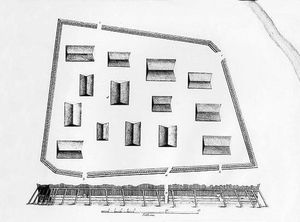 A plan and elevation sketch of the Tlingit fort Shis'kí Noow drawn by Urey Lisianski after the Battle of Sitka in 1804. The Indian River flows through the upper right corner of Lisianski's drawing.
Inasmuch as Baranov’s battlefield wounds prevented him from continuing the battle, Lieutenant Commander Lisianski assumed command, ordering his ships to begin shore bombardment of the Tlingit position. The initial barrage consisted mainly of "ranging shots" as the vessels attempted to determine the optimum firing range. Unable to breach the fort's walls, the Russians ceased fire in the early afternoon and sent a messenger ashore under a flag of truce.Much to the Kiks.ádi's amusement, the message demanded their surrender, which they rejected out of hand. The Tlingit replied with their own demand that the Russians surrender, which was also rejected. The Russian cannon fire resumed until nightfall.After dark, the Kiks.ádi met to consider their situation. They all believed that the Russians suffered too many losses the day before to mount another ground attack. The Tlingit's goal had been to hold out long enough to allow the northern clans to arrive and reinforce their numbers, but the shortage of gunpowder limited their ability to remain under siege, a factor that made ultimate victory seem less likely. The Tlingit concluded that a change in tactics was in order: rather than suffer the ignominy of defeat on the battlefield, they formulated a strategy wherein the Clan would disappear into the surrounding forest (where they felt that the Russians could not engage them) and establish a new settlement on the northern part of the island.
Day Three
The Neva and her escorts resumed their day-long bombardment of the Tlingit fort at sunrise. The Kiks.ádi responded with offers of a truce, hostage exchanges, promises of more talks, and even the possibility of surrender. Unbeknownst to the Russians, the Clan's elderly and young children had already begun the trek to Gájaa Héen (Old Sitka). At nightfall, the House Chiefs met again to discuss their planned march across the island. Mothers with infant children were to depart in the morning.
Day Four
The naval cannon fire began at daybreak, halting periodically to allow the Russians to extend offers of peace to the Kiks.ádi, which were in turn rejected. That afternoon, the Tlingit's response was that they had tired of battle, and would accede to the Russian demands to evacuate Shis'kí Noow the following day. Once the sun had set, the natives held their last gathering in the sapling fort. The elders offered praise for their clansmen who had defended the Kiks.ádi homeland against a formidable enemy. The Clan gathered together for a last song, one that ended with a loud drum roll and a wail of anguish (which the Russians interpreted as a sign of their surrender).The Tlingit then departed undetected under the cover of darkness.
 Aftermath - Contents Aftermath - Contents
It wasn't until October 7, days after the Kiks.ádi put forth their tragic " swan song," that the Russians landed a large contingent of troops to secure the beachhead and to reconnoiter the area in and around Shis'kí Noow. To their great surprise, none of the natives were to be found (unbeknownst to the Russians, the Tlingit had embarked on what is now referred to as the "Sitka Kiks.ádi Survival March").On October 8, Captain Lisianski visited the abandoned Tlingit fortification and recorded his impressions of what he saw as follows:
- Having come ashore, I observed the most barbaric sight that could bring even the most hardened heart to tremble and recoil. Assuming that we could trace them in the woods by the voices of infants and dogs, the Sitkans put them all to death...the entire set of circumstances led us to conclude that the fortress had contained no less than 800 persons of male gender.
The fort was razed to preclude the possibility of its being used as a stronghold against the Russians and their allies ever again.
"Sitka Kiks.ádi Survival March"
The first leg of the Tlingit's sojourn entailed a hike west from Gajaa Héen to Daxéit (the Clan's fishing camp at Nakwasina Sound, where each May the Kiks.ádi harvested herring eggs, a traditional native food). From there, the group's exact path across the mountains north to Cháatl Káa Noow (the Kiks.ádi "Halibut Fort" at Point Craven in the Peril Strait) is a matter of some conjecture. However, a coastal route around the bays of Northwest Baranof Island appears to be the most likely course as it would have allowed the travelers to circumvent the Island's dense forests, based on significant firsthand research into the event conducted by Herb and Frank Hope of the Sheet'ká Kwáan — Sitka Tribe of Alaska. Canoes fashioned out of redcedar trunks facilitated the ocean crossing to Chichagof Island.Several warriors remained in the vicinity of Noow Tlein after the Battle as a sort of rear guard, in order to both harass the Russian settlers and to prevent them from pursuing the Kiks.ádi during their flight north. Shortly thereafter, eight Aleut trappers were killed in Jamestown Bay and another was shot in the woods adjacent to New Archangel. From that point forward, Russian hunting parties went out in force, ever alert to the possibility of attack. The Kiks.ádi encoraged other Tlingit clans to avoid contact with the Russians by any means possible.
Russian Alaska
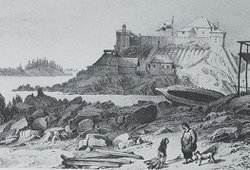 The Russian palisade atop "Castle Hill" (Noow Tlein) in Gájaa Héen (Old Sitka), circa 1827.
Atop the kekoor (hill) at Noow Tlein, the Russians constructed a fortress (krepost') of their own, consisting of a high wooden palisade with three watchtowers (armed with 32 cannon) for defense against Tlingit attacks. By the summer of 1805, a total of 8 buildings had been erected inside the compound, including workshops, barracks, and the Governor's Residence.Aside from their annual expeditions to "Herring Rock" near the mouth of the Indian River, the Kiks.ádi by-and-large steered clear of the ever-expanding settlement until 1821, when the Russians (who intended to profit from the natives' hunting prowess, and to put an end to the sporadic attacks on the village) invited the Tlingit to return to Sitka, which was designated as the new capital of Russian America in 1808.
 A replica of Russian Block House #1 (one of three watchtowers that guarded the stockade walls at Old Sitka) as constructed by the National Park Service in 1962.
The Tlingit who chose to return were allowed to reside in a part of the village just below the heavily-guarded stockade on "Blockhouse Hill" (an area known as the Ranche until around 1965). Russian cannon were constantly trained on the natives as a reminder of their defeat at Shis'kí Noow. The Kiks.ádi supplied the Russians with food (including corn, or maize, which the settlers taught them how to cultivate) and otter pelts, while the colonists introduced the Tlingit to the various aspects of Russian culture and the Russian Orthodox Church. Occasional acts of Tlingit aggression continued until 1858, with one significant uprising (though quickly quelled) occurring in 1855.After Russian America was sold to the U.S. in 1867, all of the holdings of the Russian–American Company were liquidated. Following the transfer, many elders of the local Tlingit tribe maintained that "Castle Hill" comprised the only land that Russia was entitled to sell. Native land claims were not addressed until the latter half of the 20th Century, with the signing of the Alaska Native Claims Settlement Act.The 1880 census reported a population of 43 Tlingit living in and around the Indian River, the Kiks.ádi's traditional summer fishing camp.
Tributes
U.S. President Benjamin Harrison set aside the Shis'kí Noow site for public use in 1890. Sitka National Historical Park was established on the battle site on October 18, 1972 "...to commemorate the Tlingit and Russian experiences in Alaska." Today, the K'alyaan (Totem) Pole stands guard over the Shis'kí Noow site to honor the Tlingit casualties. Ta Éetl, a memorial to the Russian sailors who died in the Battle, is located across the Indian River at site of the Russians' landing.In September of 2004, in observance of the Battle's bicentennial, descendents of the combatants from both sides joined in a traditional Tlingit "Cry Ceremony" to formally grieve their lost ancestors. The next day, the Kiks.ádi hosted a formal reconciliation ceremony to "put away" their two centuries of grief.
 Historic designations - Contents Historic designations - Contents
-
National Register of Historic Places #NPS–66000162 — "Baranof Castle Hill" site
- National Register of Historic Places #NPS–66000164 — "Battle of Sitka" site
- National Register of Historic Places #NPS–66000166 — Old Sitka ("Redoubt Saint Michael") site
|
Change Text Size:
[A]
[default]
[A] |




 |
|
|
|
|